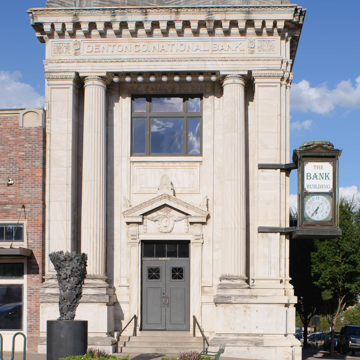This two-story, marble-clad classical corner bank by Waco architect Burnett, the only Denton financial institution to survive the Great Depression, is an exceptionally fine example of its genre. The facade has two monumental fluted Tuscan columns in antis, with compound pilasters forming the corners. Paneled pilasters mark the five-bay side wall, with ornate recessed spandrel panels and compound windows with integral pediments on the first floor. The tall entablature builds to a course of heavy modillions supporting the projecting cornice, with an open balustrade above. Renovations in 1996 replaced the wood-framed windows with aluminum, which successfully replicate the original configuration.
At the northeast corner of the square at 100 W. Oak, the plain three-story red brick Smoot-Curtis Building (1925) was designed by H. B. Thomas for Thomson and Swaine of Dallas.





















